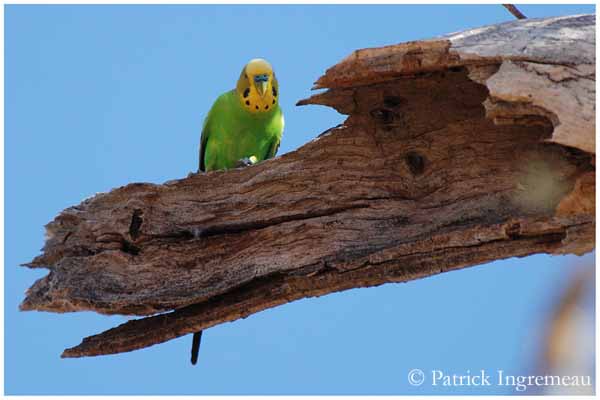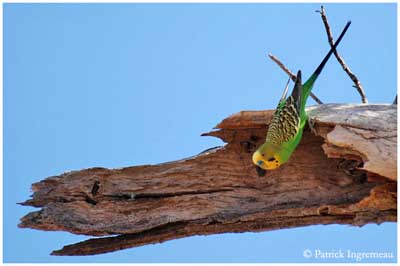
Budgerigar
Melopsittacus undulatus
Psittaciforme Order – Psittaculidae Family
BIOMETRICS:
Length : 18 cm
Weight : 22-32 g
LONGEVITY: Up to 15 years
DESCRIPTION:
Budgerigar is a small Australian parrot which survived in this continent for over five million years.
Both sexes are similar.
Adult has brownish upperparts barred black and yellow on nape, neck, upper back and wings. Upper wings show broad yellow wing bar, and dark greenish flight feathers. Rump is bright green. Graduated tail is greenish-blue, with outer tail feathers displaying oblique yellow bands in their centre. Tail is narrow and pointed.
Underparts are bright green. Tail is yellowish-green. Under wings are bright green with dark greenish flight feathers and conspicuous yellow stripe across flight feathers.
On the head, forehead and face are yellow. Ear coverts are barred as back. We can see some small violet-blue spots on lower cheeks, and black spots across the throat.
In both sexes, bill is olive-horn to olive-grey, but male has blue cere, whereas female has brown cere in breeding plumage, and paler to white in non breeding. Male and female have white eyes, and grey-blue legs and feet.
FLIGHT:
Budgerigar has swift flight. When in flocks, they perform erratic flights in tight formation. They turn and twist at the same time, and glide on down curved wings.
REPRODUCTION:
Budgerigar can breed at any time of the year, but mainly when food resources such as seeds, are abundant. Budgerigar can breed after heavy rainfalls because grass growth is more important.
They breed in large colonies and are monogamous. They are cavity nesters, but they nest in pre-existing cavities in logs or trees. We can find several nests on the same branch. Interior is filled with decayed wood dust, droppings too, and soft materials. Female chooses the nest-site.
Female lays between 4 and 12 eggs. Incubation lasts about 18 to 20 days, by female. Male feeds her during this period. Chicks are fed by both parents until they fledge, about 3 to 4 weeks after hatching. Young can breed at about 6 months of age.
This species often produces several broods in succession.
DIET:
Budgerigar feeds mainly on seeds of grasses and crop plants. It first extracts the seed from the shell, and swallows it whole or broken. It regularly drinks during the day.
PROTECTION / THREATS / STATUS:
Budgerigar is common in its range. It is very appreciated as pet for its numerous qualities, and she breeds well in captivity.
Photo by Patrick Ingremeau
TAMANDUA
Text by Nicole Bouglouan
Sources:
HANDBOOK OF THE BIRDS OF THE WORLD volume 4 by Josep del Hoyo, Andrew Elliot and Jordi Sargatal – LYNX EDICION – ISBN 8487334229
PARROTS OF THE WORLD – An Identification Guide – by Joseph M. Forshaw – Princeton University Press – ISBN 0691092516
Animal Diversity Web (University of Michigan Museum of Zoology)
Birds in backyards (Birds Australia and Australian Museum)

Juvenile is duller than adults. Throat shows indistinct black spots or lacks them. The yellow forehead is finely barred with blackish-brown. Eyes are dark brown. Tail can be shorter. Cere of the bill is pinkish-brown. It reaches its adult plumage at about 3 to 4 months of age.
There are very numerous mutations, classified in 4 basic groups: Albinism; Dilution; Leucism; Melanism.
VOICE: SOUNDS BY XENO-CANTO
Budgerigar utters a warbling “chedelee…chedelee…chedelee” as contact call. Alarm call is a harsh “squaa-aack…squaa-aack”. It also utters sharp chattering.
In captivity, Budgerigar can speak and whistle tunes. Both male and female sing.
HABITAT:
Budgerigar lives in open habitats, in semi-arid and arid areas. It can be found along ephemeral watercourses, often in eucalypts, with grassy ground providing its preferred seeds. It also frequents farmlands, parks and gardens.
RANGE:
Budgerigar lives in Australia, mainly inland. We find feral population in Florida, US, since 1940s. But this population is declining little by little, due to weather conditions.
BEHAVIOUR:
Budgerigar is very gregarious and gathers in large flocks in feeding areas. These flocks can comprise up to 100 birds or more, sometimes thousands. They forage on the ground for seeds in the morning and late afternoon. They rest during midday in hot weather. If weather is cooler, they feed all the day, coming sometimes to waterholes.
Budgerigar can alight on water surface. It is able to float with outspread wings raised above the body. They take off from water by beating wings against the surface.
At night, Budgerigar sleeps at communal roost, and departure at sunrise to feeding areas is very noisy. At the end of the day, they stunt and call loudly by flocks around the trees, before to come back to nighttimes’ roosts
